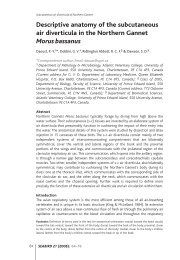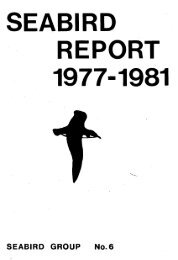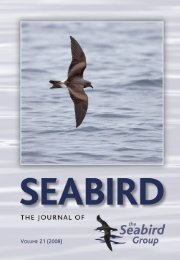Create successful ePaper yourself
Turn your PDF publications into a flip-book with our unique Google optimized e-Paper software.
2001 European Storm-petrel biology in Brittany 153<br />
days (Fig. 2). <strong>The</strong> chick with 17 days of difference was assumed to be about 10<br />
days old on 20 August, based on plumage features, but only 11-15 days old on 9<br />
September, and unhealthy; the corpse was found on a subsequent visit on 27<br />
September. Thus, with the exception of obviously retarded chicks, the difference<br />
for chicks aged twice in the season was generally less than 5 days (79.6% of the<br />
cases), and estimated laying dates for the older chicks were generally more<br />
advanced (negative values on Fig. 2). But the difference between these estimates<br />
and the true laying date remains unknown. For eight empty nests on the first<br />
visit, there was no discrepancy between the estimated laying dates and the field<br />
observations on subsequent visits (i.e. last day with empty nest and first day<br />
with an adult incubating an egg).<br />
<strong>The</strong> terminology ‘50% (or 90%) of laying’ refers below to the date, and<br />
not to the period, by which 50% (or 90%) of eggs had been laid in a given year.<br />
Breeding parameters At the end of the season, some unhatched and abandoned<br />
eggs were measured to the nearest 0.1 mm using callipers. More regular visits<br />
were made to the small islet of Enez Kreiz to obtain data on hatching and<br />
breeding success (1997: 4, 5 July, 21 August and 24 September; 1998: 4 June,<br />
23 July, 19 August and 23 September; 1999: 11, 22 June, 6, 20, 23 July, 18<br />
August and 9, 27 September). Numbers of AOS on this islet increased from 61<br />
in 1997, to 70-72 in 1998 and 122-125 in 1999. <strong>The</strong> increase from 1998 to 1999<br />
was real and not a result of the more frequent visits to the islet or to changes in<br />
census methods. Out of these identified AOS, only the sites with breeders and<br />
chicks always easily visible or accessible, and found during the incubation or<br />
brooding period, were included in analyses of breeding parameters (i.e. 46, 55<br />
and 94 nest sites for the three years respectively). Nests found late in the season<br />
at the chick stage were excluded to avoid an over-estimation of hatching and<br />
fledging success. Chicks come closer to the entrance of their burrows as they get<br />
older, and thus become more observable (pers. obs.). Breeding failure at the egg<br />
stage included all cases of broken, cracked, addled or desiccated eggs or intact<br />
unhatched eggs more than 50 days after initial observation. As breeding failure<br />
occurred at an unknown stage for some sites each year (nine in 1997, eight in<br />
1998, eleven in 1999), two calculations were made for hatching and fledging<br />
success (number of chick fledged per egg hatched), assuming that all failures<br />
occurred before or after hatching respectively (i.e. at the egg stage or at the<br />
chick stage). Minimum (or maximum) hatching success = minimum (or<br />
maximum) number of eggs hatched / total number of eggs laid; minimum (or<br />
maximum) fledging success = total number of chicks fledged / maximum (or<br />
minimum) number of eggs hatched. This uncertainty has no influence on the<br />
calculation of overall breeding success (total number of chicks fledged / total<br />
number of eggs laid). Chicks were considered to be fledged if, based on ageing








